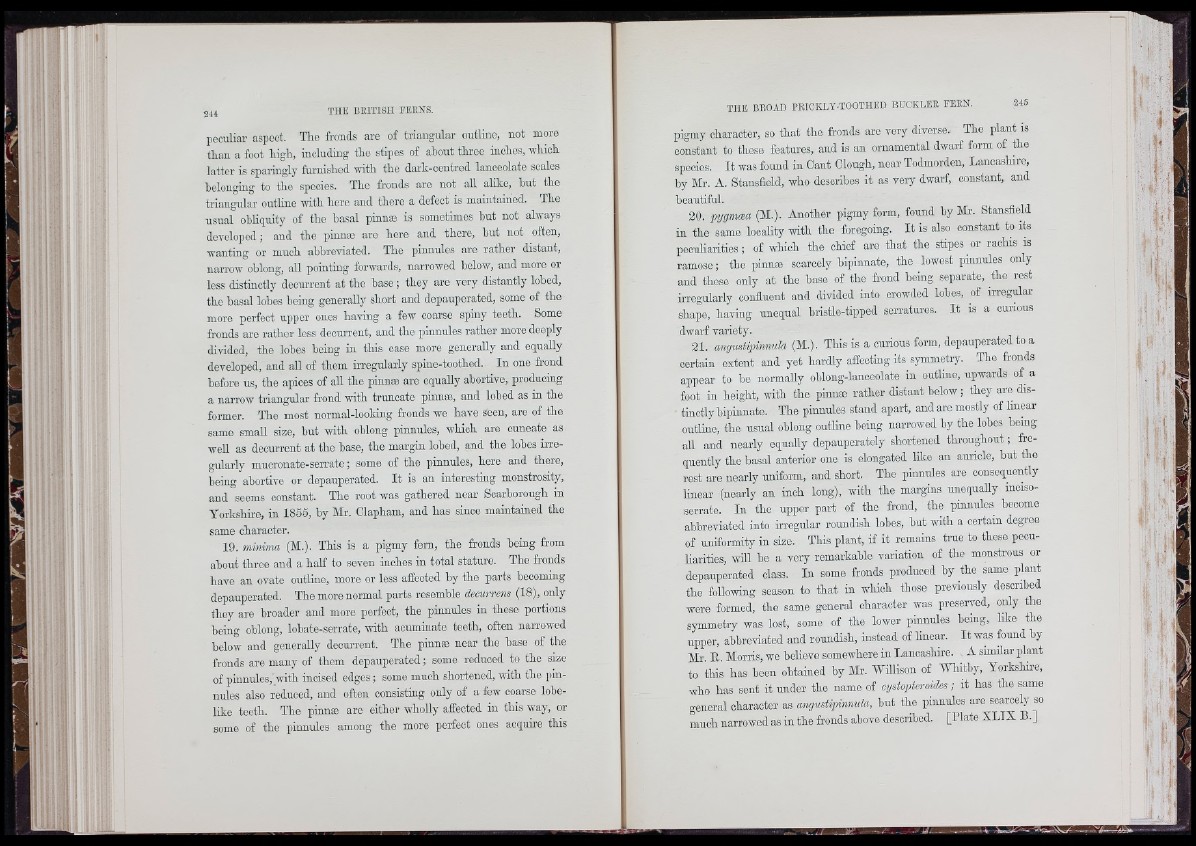
peculiar aspect. Tlic fronds aro of triangular outline, not more
than a foot high, including tho stipes of about threo inches, which
latter is sparingly furnishod with the dark-oentrcd lanooolato scales
belonging to tho species. Tho fronds aro not all alike, hut the
triangular outline wdth horo and there a defect is maintained. The
usual ohüquity of the basal pinnæ is sometimes hut not always
dovclopod ; and the pinnæ are here and there, hut not often,
wanting or much abbreviated. Tho pinnules are rather distant,
narrow oblong, all pointing forwards, narrowed below, and more or
less distinotiy decurrent at the base ; they are very distantly lobed,
tho basal lobes boing generally short and depauperated, some of the
more perfect upper ones having a few coarse sphiy teeth. Some
fronds aro rather less doom'ront, and the pinnules rather more deeply
divided, the lobes being in this case more generally and equally
developed, and all of thorn irregularly spine-toothed. In one frond
before us, the apices of aU the pinnæ are equally abortive, producing
a narrow triangular frond with trúncate pinnæ, and lobed as in the
former. The most normal-looking fronds we have seen, are of the
same small size, hut with oblong pinnules, which are cuneate as
weU as decurrent at the base, the margin lobed, and the lobes irregularly
mucronate-serrate ; some of the pinnules, here and there,
being abortive or depauperated. I t is an interesting monstrosity,
and seems constant. The root was gathered near Scarborough in
Yorkshh-o, in 1855, hy Mr. Clapham, and has since maintained the
same character.
19. minima (M.). This is a pigmy fem, the fronds being from
about three and a half to seven inches in total stature. The fronds
have an ovate outline, more or less affected hy the parts becoming
depauperated. The more normal parts resemble deeurrens (18), only
they aro broader and more perfect, the pinnules in these portions
being oblong, lobate-serrate, with aouminate teeth, often narrowed
below and generally decurrent. The pinnæ near the base of the
fronds are many of them depauperated ; some reduced to the size
of pinnules, .with incised edges ; some much shortened, with the pinnules
also reduced, and often oonsisting only of a few coarse lohc-
hke teeth. The pinnæ are either wholly affected in this way, or
some of the pinnules among the more perfect ones acquire this
pigmy character, so that the fronds aro very diverse. The plant is
constant to these features, and is an ornamental dwarf form of the
species. I t was found in Cant Clough, noar Todmorden, Lancashire,
by Mr. A. Stansfiold, who describes it as very dwarf, constant, and
beautiful.
20. pygmæa (M.). Another pigmy form, found by Mr. Stansfield
in the same locality with the foregoing. I t is also constant to its
peouliaritios; of which the chief aro that the stipes or rachis is
ramose ; tho pinnæ scarcely hipmnate, tho lowest pinnules only
and those only at the base of the frond hoing separate, the rest
irregularly confluent and divided into crowded lohcs, of irregular
shape, having unequal bristle-tipped serratures. I t is a curious
dwarf variety.
21. angustipinnula (M.). This is a curious form, depauperated to a
certain extent and yet hardly affecting its symmetry. The fronds
appear to ho normally ohlong-lanceolato in outline, upwards of a
foot in height, with the pinnæ rather distant below ; they aro distinctly
hipinnate. The pinnules stand apart, and are mostly of linear
onthne, the usual oblong outhne being narrowed by the lobes being
all and nearly equally depauperatoly shortened throughout ; frequently
tho basal anterior one is elongated like an auricle, but the
rest aro noarly uniform, and short. The pinnules are consequently
hnear (noarly an inch long), with the margins unequally inciso-
serrate. Ill the upper part of the frond, tho pinnules become
abbreviated into irregular roundish lobes, hut vdth a certain degree
of uniformity in size. This plant, if it remains true to these peculiarities,
will be a very remarkable variation of the monstrous or
depauperated class. In some fronds produced hy the same plant
the foUowing season to th a t in which those previonsly described
were formod, the same general character was preserved, only the
symmetry was lost, some of the lower pinnules being, hke the
upper, ahhreviated and roundish, instead of linear. I t was found hy
Mr E Morris, we heheve somewhere in Lancashii-e. A similar plant
to this has been obtained by Mr. Wülison of Whithy, Yorkshire,
who has sent it under the name of oystopteroides ; it has the same
general character as angustipinnula, hut the pinnules are ^scarcely so
much narrowed as in the fronds above described. [Plate XLIX B.]
I'--
• i-,--
i h *
'S
¡; 'I
i i i ’